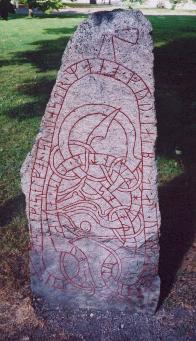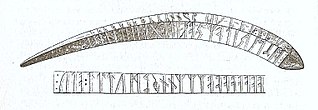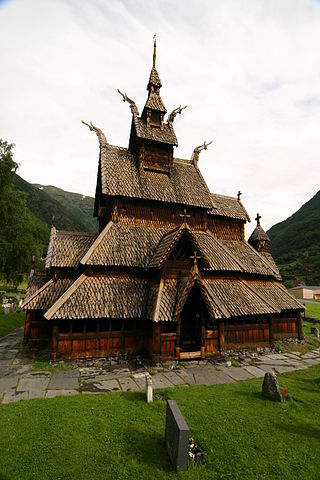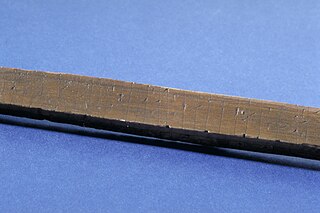Related Research Articles
In Norse mythology, Vár or Vór is a goddess associated with oaths and agreements. Vár is attested in the Poetic Edda, compiled in the 13th century from earlier traditional sources; the Prose Edda, written in the 13th century by Snorri Sturluson; and kennings found in skaldic poetry and a runic inscription. Scholars have proposed theories about the implications of the goddess.

Bryggen, also known as Tyskebryggen, is a series of Hanseatic heritage commercial buildings lining up the eastern side of the Vågen harbour in the city of Bergen, Norway. Bryggen has been on the UNESCO list for World Cultural Heritage sites since 1979.

A rune is a letter in a set of related alphabets known as runic alphabets native to the Germanic peoples. Runes were used to write various Germanic languages before they adopted the Latin alphabet, and for specialised purposes thereafter. In addition to representing a sound value, runes can be used to represent the concepts after which they are named (ideographs). Scholars refer to instances of the latter as Begriffsrunen. The Scandinavian variants are also known as futhark or fuþark ; the Anglo-Saxon variant is futhorc or fuþorc.

This runestone, listed in Rundata as runic inscription U 1011, was carved in the 11th century and was originally located at Örby, Rasbo, Sweden.

Uppland Runic Inscription 701 or U 701, and also known as Kynge stone, is a runestone that is now lost. It was recorded in a drawing in the 17th century by Johan Hadorph and P. Helgonius, as well as Johannes Haquini Rhezelius. Richard Dybeck took up the search for the missing U 701 in 1860 but was not able to find it. It is believed that U 701 was carved by the artist who made runic inscriptions U 700 and U 702. The recorded text ends with a prayer that uses the Norse word salu for soul, which was imported from English and first used on a different inscription during the tenth century.

Uppland Runic Inscription 613, also known as the Torsätra runestone, is the Rundata catalog number for a Viking Age memorial runestone originally located in Torsätra, which is approximately 8 kilometers northeast of Bro, Stockholm County, Sweden, which is in the historic province of Uppland.

Seeland-II-C is a Scandinavian bracteate from Zealand, Denmark, that has been dated to the Migration period. The bracteate bears an Elder Futhark inscription which reads as:

The Lindholm "amulet", listed as DR 261 in Rundata, is a bone piece, carved into the shape of a rib, dated to the 2nd to 4th centuries and has a runic inscription. The Lindholm bone piece is dated between 375CE to 570CE and it is around 17 centimeters long at its longest points. It currently resides at Lund University Historical Museum in Sweden.

The Skarpåker Stone, designated by Rundata as Sö 154, is a Viking Age memorial runestone that originally was located in Skarpåker, Nyköping, Sörmland, Sweden. It dates to the early eleventh century.

A runemaster or runecarver is a specialist in making runestones.
The Klepp I Runestone, listed as N 225 in the Rundata catalog, is one of two runestones from Klepp in Rogaland, Norway. It is among the few Viking Age runestones that was raised as a memorial to a woman.

N 351 is the Rundata catalog number for a medieval runic inscription carved on a piece of wood that was found at the north portal of the Borgund stave church in Norway.
Steinunn Refsdóttir was an Icelandic skald active at the end of the 10th century. Two verses by her are preserved, in which she taunts the missionary Þangbrandr.

Félag was a joint financial venture between partners in Viking Age society.

The medieval runes, or the futhork, was a Scandinavian runic alphabet that evolved from the Younger Futhark after the introduction of stung runes at the end of the Viking Age. These stung runes were regular runes with the addition of either a dot diacritic or bar diacritic to indicate that the rune stood for one of its secondary sounds. The medieval futhork was fully formed in the early 13th century. Due to the expansion of its character inventory, it was essentially possible to have each character in an inscription correspond to only one phoneme, something which was virtually impossible in Younger Futhark with its small inventory of 16 runes.

The Holmfast Inscriptions are two Viking Age memorial runic inscriptions and one image that are designated as Sö 311, Sö 312, and Sö 313 in the Rundata catalog. They are located in Södertälje, Stockholm County and the province of Södermanland, Sweden by the eponymous road Holmfastvägen.

The Bergen rune charm is a runic inscription on a piece of wood found among the medieval rune-staves of Bergen. It is noted for its similarities to the Eddaic poem Skírnismál ; as a rare example of a poetic rune-stave inscription; and of runes being used in love magic.

The Ribe skull fragment is a section of human skull bone inscribed with runes and unearthed in 1973 in an archaeological excavation at Ribe, Denmark. It dates to circa 725 CE.
The Ribe healing stick is a pinewood stick found at Ribe, Denmark, with a heavily pagan-inspired Christian spell. It dates to circa 1300 CE.
Bryggen inscription 145 is a runic inscription on a wooden stick found among the medieval rune-staves of Bergen. It has four sides, and dates to around the year 1200. It is notable not only for containing a rare Skaldic love poem in the form of a complete dróttkvætt stanza, but also a quote from the classical Latin poet Virgil, illustrating the coexistence of native Norse and Classical education in medieval Norway.
References
- 1 2 Spurkland (2005: 194-195)
- ↑ "Skaldic project".
- ↑ MacLeod, Mindy; Mees, Bernard (2006), Runic Amulets and Magic Objects, Woodbridge: Boydell Press, p. 39, ISBN 1-84383-205-4
- ↑ "Skaldic project".
- ↑ The excavation of Bryggen, Bergen, Norway Asbjorn E. Herteig in Recent archaeological excavations in Europe edited by Rupert Bruce-Mitford, page 65, Routledge, 1975 - Social Science - 335 pages